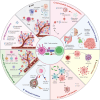The mechanisms and clinical significance of CD8+ T cell exhaustion in anti-tumor immunity
- PMID: 40492696
- PMCID: PMC12240197
- DOI: 10.20892/j.issn.2095-3941.2024.0628
The mechanisms and clinical significance of CD8+ T cell exhaustion in anti-tumor immunity
Abstract
CD8+ T cell exhaustion, a critical challenge in the immune response to cancer, is characterized by a profound decline in the functionality of effector CD8+ T cells. This state of exhaustion is accompanied by the upregulation of various inhibitory receptors and significant shifts in both transcriptional and epigenetic profiles, thus ultimately leading to inadequate tumor control. Therapeutic strategies aimed at reversing CD8+ T cell exhaustion have the potential to rejuvenate immune responses and enhance treatment efficacy. This review compiles current knowledge regarding the molecular mechanisms underlying CD8+ T cell exhaustion, including the roles of immune checkpoint molecules, the tumor microenvironment, metabolic reprogramming, transcription factors, and epigenetic modifications. Emerging therapeutic approaches designed to combat CD8+ T cell exhaustion are evaluated, with emphasis on the modulation of immune checkpoints; targeting of metabolic and transcriptional changes; and exploration of other innovative strategies, such as epigenetic editing and engineered CAR-T cells. Importantly, we expand the exhaustion concept to immune cells beyond CD8+ T cells, such as CD4+ T cells, natural killer cells, and myeloid populations, thereby highlighting the broader implications of systemic immunosuppression in the cancer context. Finally, we propose avenues for future research aimed at further elucidating the factors and molecular mechanisms associated with CD8+ T cell exhaustion, thereby underscoring the critical need for strategies aimed at reversing this state to improve outcomes in cancer immunotherapy.
Keywords: CD8+ T cell exhaustion; anti-tumor immunity; cancer immunotherapy; immune checkpoint; immune checkpoint inhibitors.
Copyright © 2025 The Authors.
Conflict of interest statement
No potential conflicts of interest are disclosed.
Figures




References
-
- Strandgaard T, Nordentoft I, Birkenkamp-Demtroder K, Salminen L, Prip F, Rasmussen J, et al. Field cancerization is associated with tumor development, T-cell exhaustion, and clinical outcomes in bladder cancer. Eur Urol. 2024;85:82–92. - PubMed
Publication types
MeSH terms
Grants and funding
LinkOut - more resources
Full Text Sources
Other Literature Sources
Medical
Research Materials
